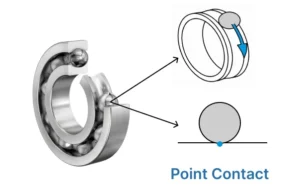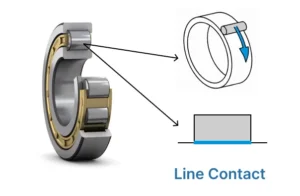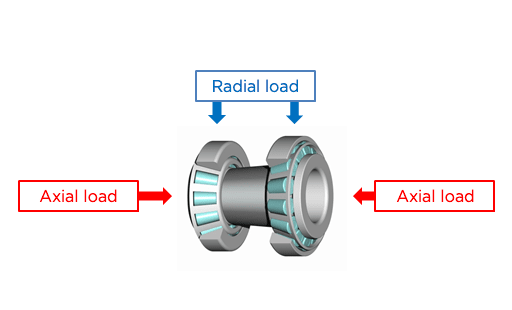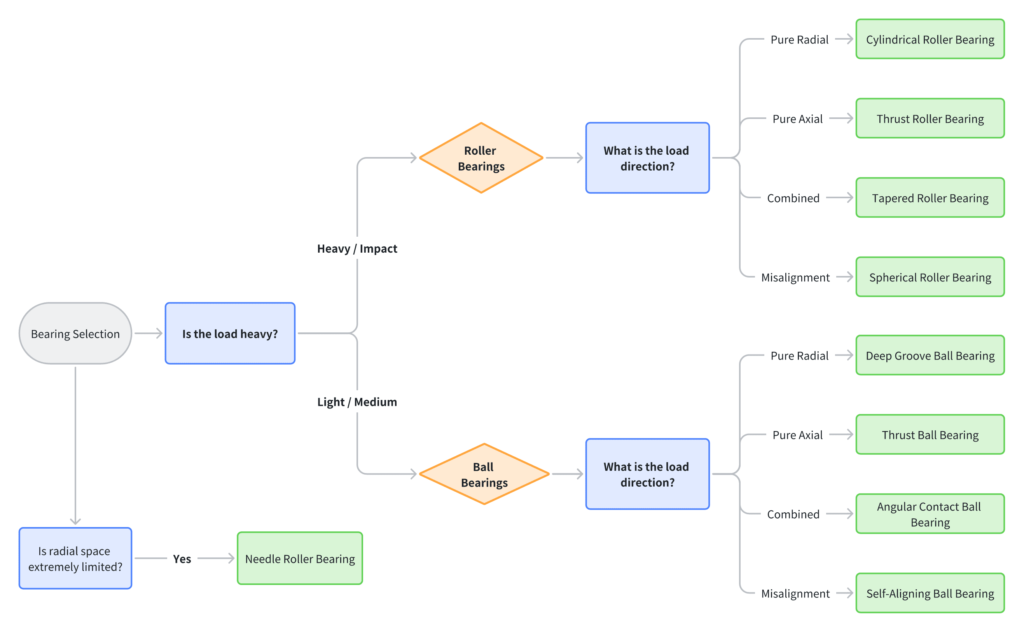Knowledge Center
How to Correctly Select a Bearing Type Based on Load, Direction, and Space
Choosing a bearing is like choosing the right shoes for an athlete. You wouldn’t ask a sprinter to wear hiking boots, or a weightlifter to wear ballet slippers. It’s the same with bearings. The first step—selecting the right type—is the most critical. A correct start will save you significant time and effort in later design stages and will ensure your equipment’s reliability from the very beginning.
Section Navigation
How to Choose the Right Bearing
- P0: The 8-Step Practical Guide to Systematic Bearing Selection
- C1: A Guide to Correctly Select a Bearing Type Based on Load, Direction, and Space
- C2: Bearing Arrangements: A Guide to Locating-Non-locating and Paired Mounting
- C3: How to Verify Bearing Size and Accurately Assess Its Lifespan
- C4: The Core of High-Precision: Balancing Speed, Precision, Fits, and Clearance
- C5: A Guide to Bearing Preload and System Rigidity Design
- C6: Choosing the Optimal Lubrication Strategy for Your Bearings
- C7: Key Design Points for Bearing-Related Components (Shaft, Housing, and Seals)
- C8: Smart Mounting and Efficient Dismounting of Bearings
Key Decision 1: First, Check the ‘Strength’ – Load Magnitude (Ball vs. Roller Bearings)
This is the first and most important judgment you need to make. How much force does your equipment handle?
- Ball Bearings: The High-Speed Athletes for Light to Medium Loads
Imagine a steel ball on a flat surface. It touches the surface at a single, tiny “point.” This is called point contact.- Advantage: A small contact area means less friction and less heat, allowing for very high speeds.
- Disadvantage: All the pressure is focused on one point, which limits its ability to handle heavy loads.
- Best for: Motors, precision instruments, fans, and other equipment that requires high speed and handles lighter loads.
- Roller Bearings: The Powerlifters for Heavy Loads and Impacts
Now, imagine a cylinder on a flat surface. It touches the surface along a full “line.” This is called line contact.- Advantage: The contact area is much larger, distributing the pressure effectively. This allows it to support heavy loads and impacts.
- Disadvantage: Friction is relatively higher, so its maximum speed is usually lower than a ball bearing’s.
- Best for: Gearboxes, rolling mills, construction machinery, and other “heavy-duty” equipment that must handle heavy loads or shocks.
Quick Rule: Choose ‘Ball’ for speed and light loads; choose ‘Roller’ for strength and heavy loads.
Key Decision 2: Next, Check the ‘Angle’ – Load Direction
Once you know whether to use a “ball” or “roller,” you need to look at the direction of the force.
- Pure Radial Load
- Scenario: The force is applied completely perpendicular to the shaft’s centerline, like the weight of goods on a conveyor roller.
- Recommended Types: Deep Groove Ball Bearings (the most common “all-arounder”), Cylindrical Roller Bearings (for heavy radial loads).
- Pure Axial Load (or Thrust Load)
- Scenario: The force is applied completely along the shaft’s centerline, like the vertical pressure on a rotating turntable.
- Recommended Types: Thrust Ball Bearings, Thrust Roller Bearings. Note: these types generally cannot handle any radial load.
- Combined Load
- Scenario: Both radial and axial forces are present at the same time. This is the case in most real-world applications.
- Recommended Types: Angular Contact Ball Bearings (handle both loads, good for high speeds), Tapered Roller Bearings (excellent load capacity and high rigidity).
Key Decision 3: Finally, Check the ‘Fit’ – Space and Special Conditions
- Limited Radial Space
- Challenge: Your design is very compact. The shaft is not small, but there is no room for a standard-width bearing.
- Solution: Needle Roller Bearings. Their “rollers” are long, thin needles, which provide very high load capacity in a very small cross-section.
- Potential for Misalignment
- Challenge: Due to manufacturing tolerances or shaft bending under load, the centerlines of the inner and outer rings cannot be perfectly aligned.
- Solution: Self-Aligning Bearings. These bearings have a special internal geometry that allows the inner ring to pivot relative to the outer ring. They can “self-adjust” to accommodate misalignment, preventing premature failure. They come in two main types: Self-Aligning Ball Bearings (for light/medium loads) and Spherical Roller Bearings (for heavy loads).
Selection Decision Tree
Conclusion
Selecting the right bearing type is not complicated. You just need to answer three questions in order: First, how heavy is the load? (This decides between ball and roller). Second, where is the force coming from? (This determines the specific design). Third, are there any special requirements? (This addresses space and alignment). By using this logic, you can quickly and accurately find the perfect “shoes” for your equipment, building a solid foundation for your project’s success.
Not finding what you need?
If you have enquiries about our product or solutionservice, please contact us via email.



